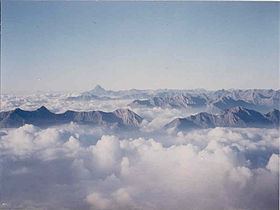Highest point Monte Viso | Elevation 3,841 m (12,602 ft) | |
 | ||
Mountains Monte Viso, Aiguille de Chambeyron, Aiguille de Scolette, Monte Granero, Mont Chaberton Similar Alps, Monte Viso, Western Alps, Maira Valley, Pennine Alps | ||
The Cottian Alps (/ˈkɒtiən ˈælps/; French: Alpes Cottiennes [alp kɔtjɛn]; Italian: Alpi Cozie [ˈalpi ˈkɔttsje]); are a mountain range in the southwestern part of the Alps. They form the border between France (Hautes-Alpes and Savoie) and Italy (Piedmont). The Fréjus Road Tunnel and Fréjus Rail Tunnel between Modane and Susa are important transportation arteries between France (Lyon, Grenoble) and Italy (Turin).
Contents
- Map of Cottian Alps 05460 Ristolas France
- EtymologyEdit
- HistoryEdit
- GeographyEdit
- BordersEdit
- PeaksEdit
- PassesEdit
- MapsEdit
- References
Map of Cottian Alps, 05460 Ristolas, France
EtymologyEdit
The name Cottian comes from Marcus Julius Cottius, a king of the tribes inhabiting that mountainous region in the 1st century BC. These tribes had previously opposed but later made peace with Julius Caesar. Cottius was succeeded by his son, also named Marcus Julius Cottius, who was granted the title of king by the emperor Claudius.
On his death, Nero annexed his kingdom as the province of Alpes Cottiae.
HistoryEdit
For a long part of the Middle Ages the Cottian Alps were divided between the Duchy of Savoy, which controlled their northern part and the easternmost slopes, and the Dauphiné, which at the time was independent from France. The Dauphins also held, in addition to the southwestern slopes of the range (Briançon and Queyras, now on the French side), the upper part of some of the valleys that were tributaries of the Po River (Valle di Susa, Chisone valley, Varaita Valley). The Alpine territory of Dauphiné, known as Escartons, used to have a limited autonomy and elected its own parliament. This semi-autonomous status lasted also after the annexation of the Dauphiné to France (1349), and was only abolished in 1713 due to the Treaty of Utrecht, which assigned to the House of Savoy all the mountainous area on the eastern side of the Cottian Alps.
After the treaty annexing Nice and Savoy to France, signed in Turin in March 1860 (Treaty of Turin), the north-western slopes of the range became part of the French republic.
Two eastern valleys of the Cottian Alps (Pellice and Germanasca) have been for centuries a kind of sanctuary for the Waldensians, a Christian movement founded by Peter Waldo and which was persecuted as heretical from the 12th century onwards.
GeographyEdit
Administratively the range is divided between the Italian provinces of Cuneo and Turin (the eastern slopes) and the French departments of Savoie, Hautes-Alpes, and Alpes-de-Haute-Provence (the western slopes).
The Cottian Alps are drained by the rivers Durance and Arc and their tributaries on the French side; and by the Dora Riparia and other tributaries of the Po on the Italian side.
BordersEdit
The borders of the Cottian Alps are (clockwise):
PeaksEdit
The chief peaks of the Cottian Alps are:
PassesEdit
The chief passes of the Cottian Alps are:
